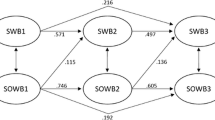Abstract
The study aimed to investigate whether social engagement predicted longitudinally objective and subjective physical health. Measures of social engagement, subjective and objective health were taken at three points in time, 4 years apart (T1, T2, T3). Three questions were examined: does social engagement at T1 predict objective/subjective health at T2, does social engagement at T2 predict objective/subjective health at T3, and does social engagement at T1 predict objective/subjective health at T3? Participants were 359 adults aged 65 and over. A fully cross-lagged structural equation model was examined. Social engagement at T1 was found to significantly predict subjective health at T2. However, social engagement at T1 did not significantly predict subjective health at T3, nor was subjective health at T3 predicted by social engagement at T2. Social engagement never significantly predicted objective health. Unexpectedly, objective health at T2 predicted social engagement at T3. Finally, post-hoc analyses suggest that age has a greater influence on social engagement at T2 than at T1. Social engagement is a useful predictor of subjective physical health. However, objective health was not predicted by social engagement—indeed, the converse was the case. It is suggested that the relationship between social engagement and subjective health is mediated by psychosocial factors which may not be present in the social engagement–objective health relationship. In conclusion, the results reflect the complex interplay of objective and subjective health and social engagement as people age.



Similar content being viewed by others
References
Bath PA, Gardiner A (2005) Social engagement and health and social care use and medication use among older people. Eur J Ageing 2 DOI 10.1007/s10433-005-0022-9
Bennett KM (2002) Low level social engagement as a precursor of mortality among people in later life. Age Ageing 31:165–168
Bentler PM (1995) EQS structural equations program manual. Multivariate Software, Inc, Encino, CA
Benyamini Y, Idler EL (1999) Community studies reporting associations between self-rated health and mortality: additional studies 1995–1998. Res Aging 21(3):392–401
Benyamini Y, Leventhal EA, Leventhal H (2003) Elderly people’s ratings of the importance of health-related factors to their self-assessment of health. Soc Sci Med 56:1661–1667
Berkman LF, Glass T, Brissette I, Seeman TE (2000) From social integration to health: Durkheim in the new millennium. Soc Sci Med 51:843–857
Bowling A, Browne PD (1991) Social networks, health and emotional well-being among the oldest old in London. J Gerontol 46(1):S20–S32
Deeg DJH, Bath PA (2003) Self-rated health, gender, and mortality in older persons: introduction to a special section. Gerontologist 43(3):369–371
de Jonge J, Dormann C, Janssen PPM, Dollard MF, Landeweerd JA, Nijhuis FJN (2001) Testing reciprocal relationships between job characteristics and psychological well-being: a cross-lagged structural equation model. J Occup Organ Psychol 74(1):29–46
Estes CL, Rundall TG (1992) Social characteristics, social structure, and health in the aging population. In: Ory M, Ableles RP, Lipman PD (eds) Aging, health and behaviour. Sage, Newbury Park, pp 299–326
Ferrucci L, Guralnik JM, Simonsick E, Salive ME, Corti C, Langlois J (1996) Progressive versus catastrophic disability: a longitudinal view of the disablement process. J Gerontol 51A(3):M123–M130
Grundy E, Sloggett A (2003) Health inequalities in the older population: the role of personal capital, social resources and socio-economic circumstances. Soc Sci Med 56:935–947
Harwood RH, Pound P, Ebrahim S (2000) Determinants of social engagement in older men. Psychol Health Med 5(1):75–85
Leonard R, Burns A (2000) The paradox of older women’s health. In: Ussher J (ed) Women’s health: contemporary international perspectives. British Psychological Society, Leicester, pp 485–489
Maier H, Smith J (1999) Psychological predictors of mortality in old age. J Gerontol Psychol Sci 54B(1):P44–P54
Maruyama GM (1998) Basics of structural equation modeling. Sage, Thousand Oakes
Mendes de Leon CF, Glass TA, Berkman LF (2003) Social engagement and disability in a community population of older adults: the New Haven EPESE. Am J Epidemiol 157(7):633–642
Morgan K (1998) The Nottingham longitudinal study of activity and ageing: a methodological overview. Age Ageing Suppl 27:5–11
Morgan K, Dallosso HM, Arie T, Byrne EJ, Jones R, Waite J (1987) Mental health and psychological well-being among the old and very old living at home. Br J Psychiatr 150:801–807
Pinquart M (2001) Correlates of subjective health in older adults: a meta-analysis. Psychol Aging 16(3):414–426
Sidell M (1995) Health in old age: myth, mystery and management. Open University Press, Buckingham
Steinbach U (1992) Social networks, institutionalisation, and mortality among elderly people in the United States. J Gerontol 47(4):S183–S190
Sugisawa H, Liang J, Liu X (1994) Social networks, social support, and mortality among older people in Japan. J Gerontol 49(1):S3–S13
Tabachnick BG, Fidell LS (2001) Using multivariate statistics, 4th edn. Allyn and Bacon, Boston
Uchino BN, Cacioppo JT, Kielcolt-Glaser JK (1996) The relationship between social support and physiological processes: a review with emphasis on underlying mechanisms and implications for health. Psychol Bull 119(3):488–531
Unger JB, McAvay G, Bruce ML, Berkman L, Seeman T (1999) Variation in the impact of social network characteristics on physical functioning in elderly persons. MacArthur Studies of Successful Aging. J Gerontol 54B(5):S245–S251
Zunzunegui MV, Alvarado BE, Del Ser T, Otero A (2003) Social networks, social integration, and social engagement determine cognitive decline in community-dwelling Spanish older adults. J Gerontol Ser B Psychol Sci Soc Sci 58(2):S93–S100
Zunzunegui MV, Kone A, Johri M, Beland F, Wolfson C, Bergman H (2004) Social networks and self-rated health in two French-speaking Canadian community dwelling populations over 65. Soc Sci Med 58(10):2069–2081
Acknowledgements
The Nottingham Longitudinal Study of Activity and Ageing is supported by grants from The Grand Charity, Help the Aged, the PPP Medical Trust and from the Trent Regional Health Authority. I would like to thank the anonymous reviewer for comments on an earlier draft of this paper.
Author information
Authors and Affiliations
Corresponding author
Additional information
This article was previously published with DOI s10433-005-0016-7, which was mistakenly created twice and has therefore been replaced by the current DOI.
Rights and permissions
About this article
Cite this article
Bennett, K.M. Social engagement as a longitudinal predictor of objective and subjective health. Eur J Ageing 2, 48–55 (2005). https://doi.org/10.1007/s10433-005-0501-z
Published:
Issue Date:
DOI: https://doi.org/10.1007/s10433-005-0501-z




